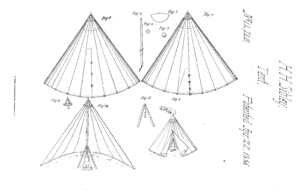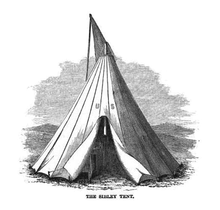Sibley tent

The Sibley tent was invented by the American military officer Henry Hopkins Sibley and patented in 1856. Of conical design, it stands about 12 feet (3.7 m) high and 18 feet (5.5 m) in diameter.[1] It can comfortably house about a dozen men.[2]
The Sibley design differed from other conical tents, or bell tents in a number of ways. Sibley's design is supported by a central pole that telescopes down into the supporting tripod so that it takes less space to pack and store. The tripod could be erected over a firepit for cooking and heat. The Sibley design also required no guy ropes, being held down by twenty-four pegs around the base.[1][3] Additionally, unlike earlier designs, the use of a cowl over the central pole allowed for ventilation and for the escape of smoke, regardless of wind direction.[4]
History

The US Patent Office granted Sibley his patent April 22, 1856 (no. 14,740). The US Army used the tent exclusively during the Utah Expedition during the winter of 1857–58, proving the design. Several of the Plains Indian Wars veterans noted the tent's similarity to Indian lodges—the smoke hole, the tent pegs around the outer edge, the fire pit, etc.[6][7]
In accordance with an 1858 agreement with the Department of War, Sibley would receive $5 USD for every tent made. However, Sibley resigned from the US Army to join the Confederate States Army after the outbreak of the American Civil War. He received no royalties on his patent. The Union Army produced and used nearly 44,000 Sibley tents during the war.
After Sibley's death, his relatives attempted unsuccessfully to collect the royalties from the War Department.
See also

References and notes
| Wikimedia Commons has media related to Sibley tents. |
- Bibliography
- Billings, John D. Hardtack and Coffee: Or, The Unwritten Story of Army Life. Boston: George M. Smith & Co. (1887).
- Harrington, Charles, M.D. A Manual of Practical Hygiene, for Students, Physicians, and Medical Officers. Philadelphia: Lea Brothers & Co. (1902).
- Marcy, Randolph B., Capt. The Prairie Traveler: A Hand-Book for Overland Expeditions. New York: Harper & Brothers, Publishers (1859).
- Sibley, H.H. "Conical Tent", U.S. Patent No. 14,740: United States Patent Office (April 22, 1856).
- Citations
- 1 2 Sibley, "Conical Tent"
- ↑ Marcy, The Prairie Traveler, p. 143: "The tent used in the army will shelter comfortably twelve men."
- ↑ Marcy, The Prairie Traveler, p. 142-143: "A tent has been invented by Major H.H. Sibley, of the army, which is known as the "Sibley tent." It is somewhat similar to the Comanche lodge but, in place of the conical frame-work of poles, it has but one upright standard, resting upon an iron tripod in the centre. The tripod can be used to suspend cooking utensils over the fire and, when folded up, admits the wooden standard between the legs, thereby reducing the length by half, and making it more convenient for packing and traveling."
- ↑ Harrington, A Manual of Practical Hygiene, p. 601: "The English army uses the circular, or bell, tent. ... Formerly, the ventilation was practically nil, but now it has been somewhat improved."
- ↑ Marcy, The Prairie Traveler, p. 143.
- ↑ Marcy, The Prairie Traveler, Chapter V,
- ↑ Billings, Hardtack and Coffee, pp. 47-48: "The Sibley tent was invented by Henry Sibley, in 1857. He was a graduate of the United States military academy at West Point and accompanied Capt. John C. Fremont on one of his exploring expeditions. He evidently got his idea from the Tepee or Tepar—the Indian wigwam of poles covered with skins, and having a fire in the centre—which he saw on the plains."
.svg.png)